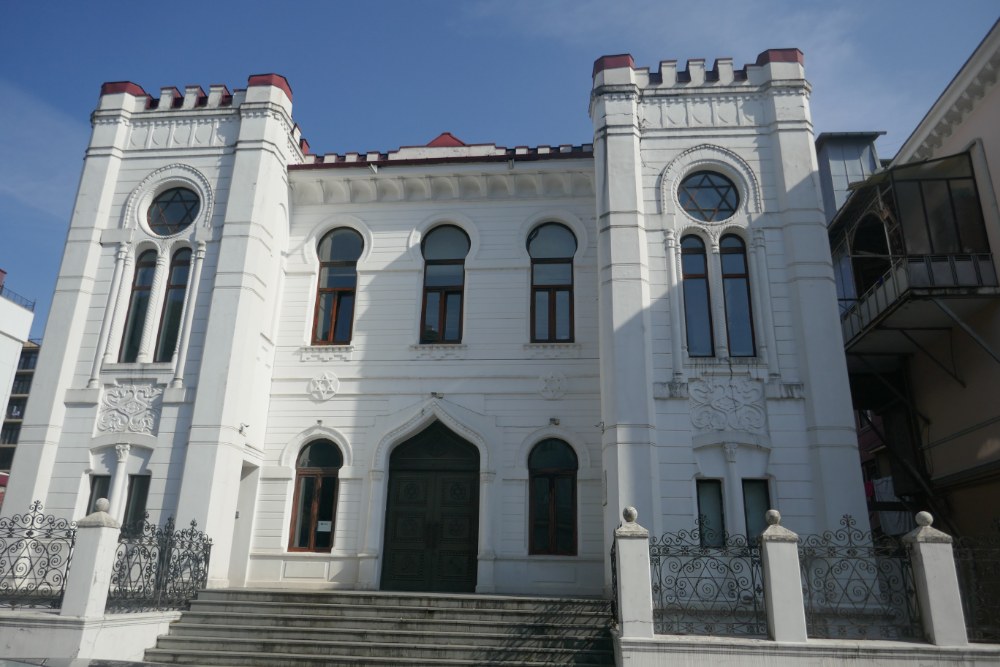
Batumi Synagogue is located at 33, Vazha-Pshavela Street.
Phone: +995 555 36 66 99
Coordinates: 41.647359, 41.634441
The building stands on a quiet, light-colored street and stands out with its snow-white facade with side towers. The ornamentation of the Star of David makes the building easily recognizable. The windows are decorated with carved decorative elements and patterns. Six-pointed stars can be seen in the window openings.
Entering the spacious hall, one feels how modern and open it is. The white walls, towering columns and light-colored decoration add to the sincerity of the place.
When the blue Batumi sky peeks through the round windows of the synagogue and the spacious hall is flooded with sunlight, the whole room seems to float in its rays, causing a unique sublime state.
The Jewish community in Batumi is small, but the minyan almost always gathers for prayer. Here the Torah is read and all Jewish holidays, rituals and events are held. On the days of Sukkot holiday, festive tents are set up. The shofar is trumpeted on Rosh Hashanah.
The prayers are led by Rabbi Ze’ev Mendelson. His wife and assistant is Rabanit Mushi.
The Jewish community in Batumi is engaged in religious, educational and charitable affairs. Much attention is paid to the history and traditions of the Jewish people.
The organization “Chesed” is located on the second floor of a two-storey building in the courtyard of the synagogue and is mainly engaged in charity: care for elderly and lonely Jews.
A kosher restaurant is located in Beit Habad, but its operation is not permanent. The first kosher restaurant Mendi’s began operating in Batumi in 1995.
The synagogue building was designed by the architect Semyon Lvovich Volkovich on the model of the Hague and Amsterdam synagogues. The construction was carried out in the period 1900-1904.
Officially, the Jewish community in Batumi has existed since 1878. At that time there were two communities – Ashkenazi (European) Jews and Georgian Jews.
At that time Ashkenazi Jews did not have their own capital building. They gathered in a small wooden house bought from a subject of the Ottoman Empire.
In 1879, the first entry was made in the pinkos (record books) kept in the prayer house.
Presumably in the early 1880s a synagogue was also opened for Georgian Jews.
In 1882, according to the census, out of 8671 inhabitants of Batumi there were 179 Jews. In the census of 1890 there were already 862 Jews, and according to the census of 1897 out of 28508 inhabitants of the city, the number of Jews was 1179 people.
Of course, the small wooden building, designed for about 20 people, could not accommodate all those wishing to come to prayer.
Batumi Jews appealed to the government three times for permission to officially open the House of Prayer, and later to build a capital stone building, but all their requests were rejected.
Finally, in 1899, the Jews of Batumi petitioned the head of state, Emperor Nicholas II. They asked for permission to build a stone building of a choral synagogue at their own expense, in which they could pray for the dispensation of an heir to the throne to the Emperor.
The appeal of the Jewish community was conveyed through the merchant Psaros, who passed it on to the capital’s bankers, and they to the minister.
After reading the petition, Nicholas II. felt so much for the cause that he wrote with his own hand, “I authorize it. Nicholas.” In the year of completion of the synagogue construction the Emperor had an heir – Tsesarevich Alexei.
For the opening of the synagogue in Batumi, a silver goblet was made in Warsaw, on which the names of the largest donors were engraved. Each of them contributed at least 1000 rubles to the construction of the synagogue. The cup was accompanied by a set of six cups.
The Ashkenaz synagogue functioned until March 1923, after which the new authorities handed over the building to the Communist Youth Union of Adjaristan. The building housed the “Dynamo” sports society, a gymnasium was equipped and competitions were held.
In 1924 Georgian Jews succeeded in opening a synagogue in the building they had bought, with which an illegal yeshiva functioned until the 1940s.
In 1922-1928 the rabbi of Batumi was N.-Sh. Sasonkin.
In 1925-1929 there was a four-year Jewish school in Batumi.
In the late 1930s this synagogue was closed.
It was only in 1992 that the synagogue was returned to the Jews of Batumi.
By November 1998, thanks to the care and financial assistance of the Adjarian authorities, as well as donations from private sponsors, the building was fully repaired and reconstructed, and the majestic synagogue was restored to its original marvelous appearance. The dream of the Jews of Batumi came true – the synagogue began to fulfill its direct function again.
Four Torah scrolls are kept in the aron-codesh of the synagogue. Three of them were transferred from the previous synagogue, the fourth was donated by the Jewish community of Tbilisi.
In 2011, the Batumi synagogue was granted the status of a cultural heritage site.
In 2015, the State Agency for Religious Affairs, based on the report of the “Recommendation Commission for the Study of Property and Financial Issues”, transferred the synagogue building to the ownership of the Jewish community.
But by 2001, the Jewish population of Batumi numbered less than 100 people (due to the mass emigration of Jews in 1980-1990s to Israel, USA and other countries). As a result of emigration, approximately 80% of the Jewish population left the city.
The restoration of Jewish life in Batumi began in the late 1980s. On the initiative of Emil Krupnik, Hebrew study circles were established. In 1989, a branch of the Association of Georgian-Israeli Relations was founded, headed by Krupnik, who also became the director of the Jewish Sunday school in 1991. He and his sister Riva Krupnik made a huge contribution to the development of Jewish life in Georgia.
Now hundreds of Jews coming from all over the world are sure to come to this holy place to pray in the synagogue together with Rabbi Ze’ev and local Jews and to familiarize themselves with the history of the local Jewish community.

